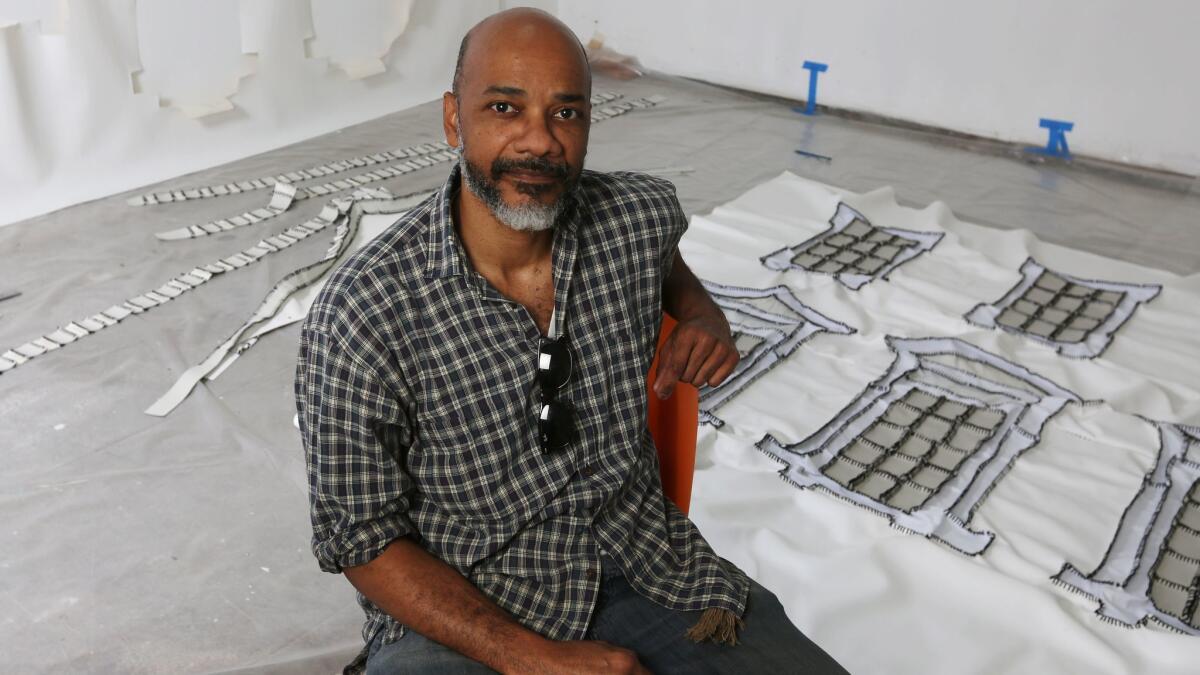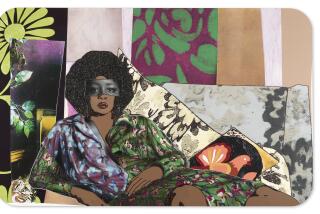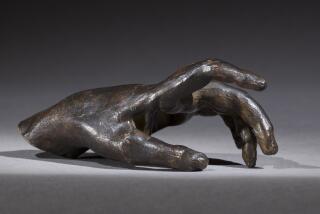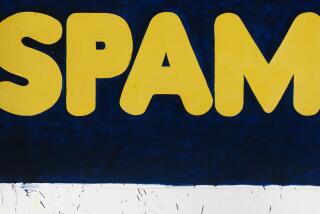L.A. artist Rodney McMillian peels back the facade on the ultimate symbol of power: the White House

Spread out on the floor of Rodney McMillian’s Los Angeles studio is a piece of the White House. To be certain, it’s not part of the actual White House, but , McMillian’s handcrafted approximation — its tidy rows of symmetrical windows and neoclassical pediment rendered in a patchwork of floppy white vinyl bound with black thread.
“It’s handmade, it’s hand-stitched,” he says, gesturing at the floor. “It’s movable and malleable.”
And it will hang like a curtain in the artist’s exhibition at the Contemporary Austin next month in the Texas capital. Visitors will peel back the vinyl to reveal an installation that ruminates on the nature of our nation’s most idealized symbols of power in ways that are spectral and surreal — not to mention a little bit humorous.
That piece consists of an 18-minute film called “Untitled (neighbors),” which features four figures in white hooded robes — not quite Ku Klux Klan robes, but certainly evocative of them — emerging from a watery landscape at dusk. As night falls, the figures perform abstracted dance rituals in the woods before converging on an illuminated neoclassical gazebo. At first they approach reverently, but as the minutes pass they begin to hungrily grope and thrust at the Doric columns, as if the crisp architecture had unleashed an unexpected attack of grinding lust.
“I wanted a defiling of an image of power as well as the representation of power — but also a place that has sentimentality because it’s a gazebo,” McMillian says. “The gazebo is symbolic in the same ways that other types of neoclassical architecture are.”
Inspired by the ancient Greeks, neoclassical architecture speaks to some of Western civilization’s most noble ideals — notions of symmetry and harmony and principles of representative democracy. It is no coincidence that the principle buildings of the U.S. federal government were designed in this style, including the U.S. Capitol, the Supreme Court and the White House.
I wanted a defiling of an image of power as well as the representation of power.
— Rodney McMillian, artist
But high-mindedness of purpose, doesn’t always translate to high-mindedness in practice. The U.S. Capitol was built in part by slaves, as was the White House. In fact, roughly a dozen of its occupants over the course of its history have owned slaves, including George Washington, Thomas Jefferson and Andrew Jackson (the latter of whom once placed an ad for a runaway that offered $10 extra for “every hundred lashes any person will give him”).
It was from the White House — a building that one architecture writer described as containing an “air of reticence and good breeding” — that Jackson oversaw the Indian Removal Act of 1830 and that Franklin Delano Roosevelt signed an executive order that condemned Japanese Americans to internment camps almost a century later.
The current occupant has shown support for maintaining monuments to Confederate leaders and wants to build a border wall to keep out Mexican immigrants, whom he has derided as “rapists” and criminals.
A container inspired by the most progressive ideals has at times been a container for exclusion. In his work, McMillian has us literally peel back the idealized facade to examine the ideological muck underneath.
Buildings such as the White House, the artist explains, “purport ideologies around democracy and possibilities that those ideals espouse. I’ve been intrigued with them as symbols, but also in asking if the institutions are doing the job that the elected officials are slated to do. Or, for whom are they doing the job?”
McMillian’s film contends with these issues in ways that are sensorial and surreal.
“The idea of haunting,” he says. “What’s left behind. What are the traces? It’s the present tense of haunting.”
The installation is part of McMillian’s first solo exhibition at the museum. “Against a Civic Death,” which opens at the Contemporary Austin on Feb. 1, is the result of McMillian winning the museum’s inaugural Suzanne Deal Booth Art Prize, a new biannual award that includes a $100,000 prize, a solo show and a catalog (currently in production).
The Contemporary’s chief curator Heather Pesanti, who sat on the prize jury and organized the show, says the honorific is “really about providing artists with unfettered space for their ideas.”
In the case of McMillian, those ideas touch on long-running questions of history whose tentacles reach right into the present. His work achieves this in ways both stark and elegiac.
“It’s not reactionary — it’s not an artist picking up on what’s happening now,” Pesanti says. “The way that he hovers between abstraction and representation. There is a poetry to his work. It’s not didactic, but it has very specific references: the Klan or the White House or Shirley Chisholm” — the first black woman elected to Congress and first black politician to run for president.
“But he leaves everything very open-ended,” she adds. “His work is so interesting because it operates on so many levels.”
The speculative reminds me that there are other narratives.... And those narratives can shift and move.
— Rodney McMillian, artist
McMillian is affable in person, prone to thoughtful answers (and questions) and generous smiles. Born in Columbia, S.C., he’s lived in Southern California since 2000, when he arrived to complete a master’s in fine arts at the California Institute of the Arts. The ways in which power and symbols are wielded has been a long-running theme in his work, which he has presented in solo exhibitions at institutions such as the Studio Museum in Harlem and the Institute of Contemporary Art in Philadelphia. For now, there are no plans for the Austin installation to travel — but one hopes it might draw the attention of a curator in Los Angeles, where McMillian has yet to have a solo museum show.
“The language that has been used politically, it has been around for decades,” he says, seated amid an array of works-in-progress in his cluttered storefront studio in Cypress Park. “These organizations are around. These sentiments are around. These desires for achieving the possibility of the ideals that house our most treasured civic institutions are alive as well.”
“History,” he adds, “is present tense. It’s present for me.”
In 2004, McMillian created a painting of the U.S. Supreme Court building in swirling shades of blue that show the normally impregnable-looking structure sliding off the wall, as if it were becoming a watery puddle. For the 2012 group exhibition “Blues for Smoke,” organized by Los Angeles’ Museum of Contemporary Art, he recreated the interior of a rural black church out of red vinyl in an installation titled “From Asterisks in Dockery.”
Altogether, these structures — the White House, the Supreme Court, a humble church — represent sites of “power and indoctrination” to the artist. “They are the places where the body exists within,” he says. “They are sites where individuals are making the institution run.”
Visitors to the Contemporary Austin will be greeted by the White House sculpture and the film, with its dream-like sequence that Pesanti describes as part “ghost story,” part “dance.” From there, the show progresses to a sequence of galleries that travel from whiteness to blackness.
This includes his 2016 installation, “pod: frequencies to manifestationing,” which the artist previously displayed at Susanne Vielmetter Los Angeles Projects in Culver City. The work consists of a series of still-life arrangements of painted black vases surrounding an amoebic “pod,” all bathed in a soundscape that melds fragments of a speech by Chisholm with a jazz track by Alice Coltrane.
“The installation not only pays homage to [Chisolm’s] continuing relevance,” wrote Times reviewer Sharon Mizota, when the work was first displayed in Los Angeles last year, “it charts a tension between familiar boundaries and what might be possible if they shattered.”
McMillian says the piece draws from a long-running interest in Chisholm and what she represents.
“My parents were inspired by her,” he says. “Growing up, she was always around. And then over the past several years, thinking about progressive movements and this past election, thinking about the history of women in presidential politics and the history of progressive politics. She was at the forefront of that.”
Another work titled “prism,” also from 2016, consists of a large accordion-like structure from which emanates the sound of the artist’s own voice — crooning the Earth, Wind and Fire tune “That’s the Way of the World.”
“It’s a beautiful song,” he says — one that pairs well with the Chisholm piece. “It’s of the time period, early ’70s, aspirational. And Afrofuturism was a huge component of the band’s costuming — the intergalactic possibilities of mankind. I thought it was a necessary song for this work.”
McMillian is intrigued by the alternate realities presented by Afrofuturism — as well as the speculative fiction of novelists such as Octavia Butler and Samuel R. Delany.
“The speculative reminds me that there are other narratives,” he says. “Those histories are a narrative by the writer at the time. And those narratives can shift and move.”
And ultimately, that is one of the principal ideas explored by McMillian’s work. For while he is keen on turning over bits of the past and the present, he reimagines them in the process, reconsidering not just what was, but the possibility of what could be.
“It’s the beauty of thinking about it, about our political structures,” he says. “These things are ideas that can be shifted and changed. Each day is a new possibility of how we can change the structure, of what we can do individually and we can do collectively.”
His White House facade is pliable. It can be moved. Over the course of the show in Austin, it will likely stretch and shift and come to bear the fingerprints of all those came through.
The hard facades of the actual White House in Washington evolve far more slowly. But the ideas contained within remain flexible. Perhaps it’s a matter of walking in and changing them.
+++
Rodney McMillian: “Against a Civic Death”
When: Opens Feb. 1 and runs through Aug. 26
Where: The Contemporary Austin, 700 Congress Ave., Austin
Info: thecontemporaryaustin.org
Sign up for our weekly Essential Arts & Culture newsletter »
ALSO
How white tables set with black vases serve as a reminder of the struggle for civil rights
How the black radical female artists of the ‘60s and ‘70s made art that speaks to today’s politics
Naima Keith’s Electric Vision: Giving the California African American Museum a Jolt of Energy
More to Read
The biggest entertainment stories
Get our big stories about Hollywood, film, television, music, arts, culture and more right in your inbox as soon as they publish.
You may occasionally receive promotional content from the Los Angeles Times.











